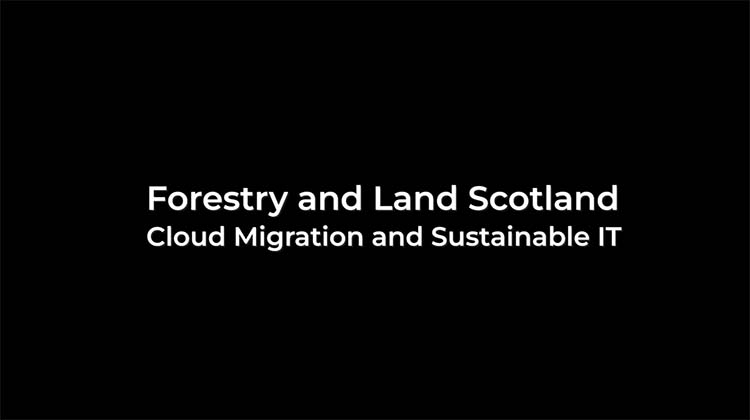It may be no surprise for anyone intrigued by Nessie, the mysterious Loch Ness monster that first appeared as many as 1,500 years ago from the 230-meter-deep body of freshwater nestled in the Scottish Highlands. Scotland is home to some of nature’s most wondrous creations. As climate change increasingly threatens ecosystems around the globe, IT professionals in Scotland are relying on modern data technologies to manage their precious forests and land.
Many know Scotland for its nearly 12,000 kilometers of subarctic coastline, the production of scotch whiskey, tartan kilts, blaring bagpipes and shaggy-haired highland cattle. It’s the home of Harry Potter and contemporary musicians such as Paulo Nutini, Chvrches and Cocteau Twins to name a few. It’s a place where past and present intertwine and move together into the future with the help of innovative people like Nick Mahlitz, senior digital infrastructure manager at Forestry and Land Scotland.
“Our mission is to look after our land and enhance the management of the land and forest for the people of Scotland and manage it on their behalf…to manage that in a sustainable way…and really provide what Scotland is to its people,” Mahlitz told The Forecast.
Forestry and Land Scotland manages more than 1.5 million acres of national forests. The agency isn’t run by the Scottish Government or supported by public funding. Instead, it relies on timber and venison sales, hosting events and other activities to generate revenue. It employs over 1,000 people, including lumberjacks and archaeologists.
After leaders decided the agency would do away with IT infrastructure and operate in the public cloud, Mahlitz found an innovative way to take old and newer applications from their Nutanix Cloud Platform-powered data center – it ran 300 virtual machines, delivering databases and back office applications – and run them on public cloud infrastructure.
By using Nutanix Cloud Clusters (NC2), he was able to replicate his on-premises data center operations and run it inside Microsoft Azure. This allowed him to migrate production workloads without refactoring applications in order to run them in the public cloud.
“What we're doing is quite unique,” he told Diginomica.
“We're taking an entire data center, you know, 300 applications, 30 terabytes of data, from on premise to a public cloud using Nutanix. It's very much a trailblazing kind of use case for the public sector because in the public sector, nobody's taking a risk.”
As part of a five-year IT transformation program, this hybrid cloud strategy rolled out in early July 2023. Testing across private and public clouds will continue until the end of year, when their private data center contract ends. After that, their Nutanix-powered IT operations will be fully running in the public cloud.
Initially, Mahlitz and his team saw NC2 as a temporary way to operate while they re-engineered applications to run natively on Azure.
“To re-engineer workloads into cloud takes significant money and resources in terms of skills, which is a big problem in the world: finding and keeping good cloud skilled people,” he said.
NC2 allowed Mahlitz’s team to use familiar tools to quickly migrate their data center to the public cloud, which freed up their skilled IT managers to concentrate “on other things like AI and automation and other new exciting technologies.”
He said these efforts will also help Scotland work toward net zero emissions goals since the move to the public cloud will improve IT sustainability by reducing the organization's carbon footprint by up to 40%.
“Our data center is another big area where we can reduce that by using public cloud and NC2,” he said.
From Highlands to High Tech
Mahlitz was born and has always lived in the highlands of Scotland. He became interested in technology at an early age. He has spent the last 20 years managing and building data centers with an eye on efficiency, reliability and sustainability. He’s seen technology shift from being centralized to being spread out to the edge then shift back again into the data center.
“It's a challenging, exciting pursuit full of unknowns,” he said. “Now we're seeing this pattern repeat with edge technology and cloud computing. We've got some real opportunities here.”
The Forestry and Land Scotland agency is only four years old, so by nature, it embraces the promise and benefits of cloud computing. Seeing how the agency is using NC2 as a migration path to public cloud can help other private and public sector organizations facing similar mandates.
“There's been so much good work done by the Scottish government and realizing all the technologies to migrate to public cloud, but what we are doing, no one else has done,” Mahlitz said. “If I can avoid the challenges around recruitment, which is a particularly challenging thing in the UK to reduce our footprint, then I think other organizations in government and public sector should also look to and analyze both your native cloud approach and using technology like NC2.”
Mahlitz Also, the ability for NC2 to manage existing product licences on the new platform and use its data replication tools for automation will be beneficial to the government agency, Mahlitz told Diginomica.
Into the Future with Cloud and Edge Computing
Technology is becoming an essential tool for monitoring and managing environments. It’s becoming even more useful and critical to Scotland and it’s challenging terrain, remote locations and extreme weather.
“Exploring all realms of technology will only help us better manage Scotland's forests and our land,” Mahlitz told The Forecast.
He’s thinking about how data technologies can protect forests by identifying and caring for diseased trees.
“The ability to use drones to scour around a forest using AI, pattern matching algorithms and software to find the trees that are diseased and stop that spreading,” especially when those trees are located in the middle of nowhere, he said.
“Technology is playing a part in that because we can deliver services to these rural areas that are in isolation in a better way.”
These and future technologies are important the agency’s mission and how it helps Scotland and the world create new ways for addressing climate change.
“It's an exciting world with exciting challenges ahead of us,” said Mahlitz. “And with the advent of cloud computing, we've got some real opportunities here.”
Editor’s note: Learn more about how Forestry and Land Scotland uses Nutanix Cloud Clusters (NC2) in this case study.
Ken Kaplan is Editor in Chief for The Forecast by Nutanix. Find him on Twitter @kenekaplan.
Jason Lopez contributed to this story. He’s the executive producer of Tech Barometer, the podcast outlet for The Forecast. He’s the founder of Connected Social Media. Previously, he was executive producer at PodTech and a reporter at NPR.





